
The Aliens Strike Back — Independence Day: Resurgence
Markus Förderer, BVK shoots intergalactic action for the sci-fi sequel.

Unit photography by Claudette Barius, SMPSP, courtesy of Twentieth Century Fox
In 1996, a powerful and violent alien invasion brought the world to its knees and devastated major cities across the globe. If not for the genius of satellite expert David Levinson (Jeff Goldblum) and the bravery of Marine Corps Capt. Steven Hiller (Will Smith), humanity would surely have perished. In an epic speech to rally a ragtag band of American pilots, President of the United States Thomas J. Whitmore (Bill Pullman) announced that the final battle, fought on July 4, would mark the date as not just an American holiday, but as the day the entire world declared its independence as a united planet:
Twenty years later, the nations of Earth have partnered to form an immense defense program. Scavenging downed alien spacecraft, scientists have studied the engineering and integrated extraterrestrial technology into the Earth’s weaponry to better defend the human race if the aliens ever return. And return they do, in an unprecedented force that no one could have predicted in Independence Day: Resurgence:
Writer-director Roland Emmerich returned to helm this long-awaited sequel to his blockbuster action film — this time with Markus Förderer, BVK at his side to bring the colossal tale to the big screen. Förderer’s previous work includes the Mike Cahill-directed drama I Origins (AC Sept. ’14), along with Emmerich’s Stonewall. “The main challenge of something like this is, how do you make the movie look consistent in its own universe, but still have an interesting take and variety to it?” says Förderer. “My goal was to make it feel like an Independence Day film, but to give it its own character.”
The original film (shot by Karl-Walter Lindenlaub, ASC, BVK; AC July ’96) has a particularly special place in the cinematographer’s heart. “I watched the first Independence Day in the theater with my sister and I thought, ‘Oh, my God, this is amazing! I have to become a filmmaker!’” Förderer recalls. “I started reading books and figured out that what I was really interested in was cinematography. Independence Day was the film that sparked that in me. I know that movie inside and out; I had it on VHS and I watched it hundreds of times as a kid.
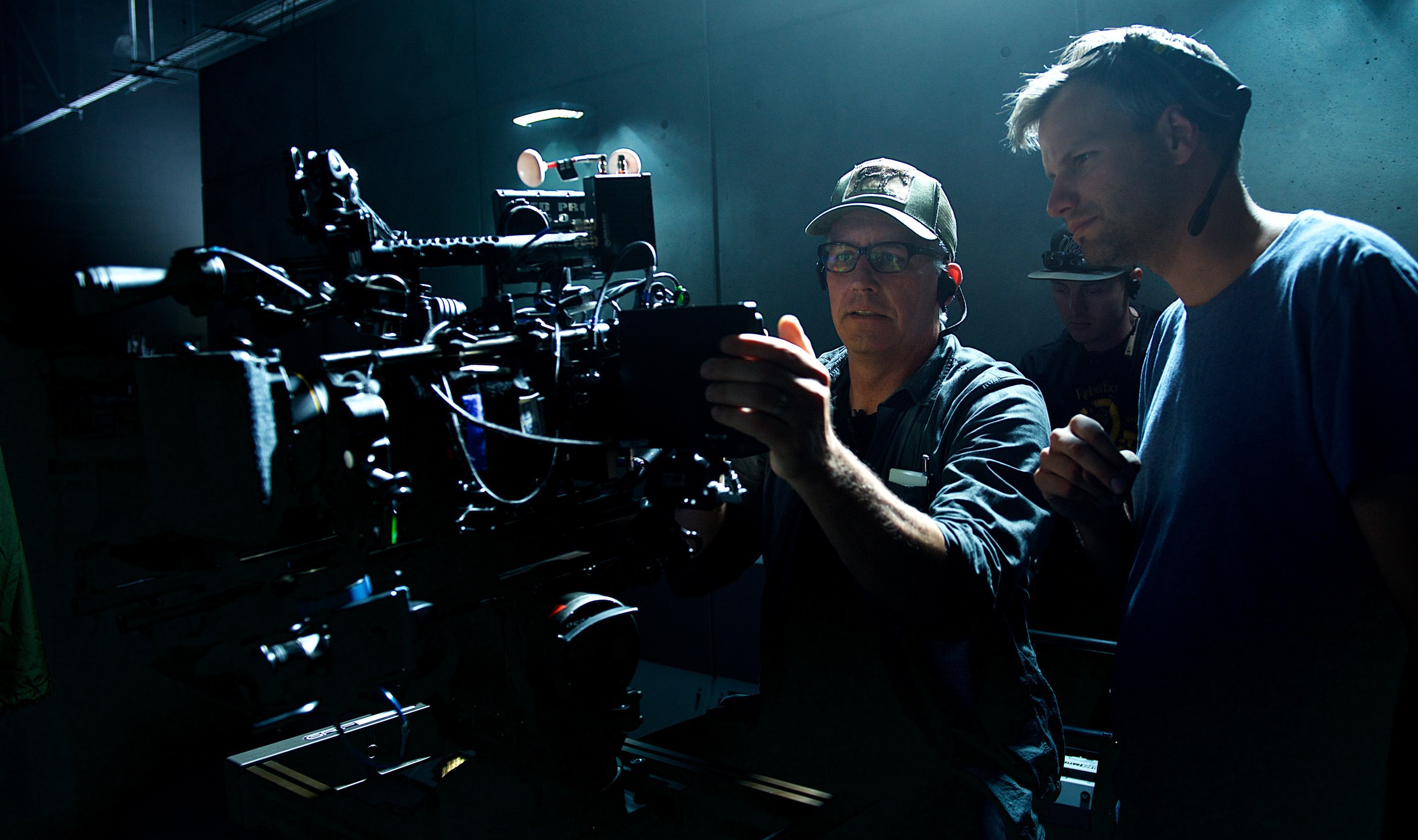
“For Resurgence, Roland wanted a really dark look,” he continues. “Usually you fight as a cinematographer to make [a movie] interesting and darker, and the director will say, ‘I want to see the performance! I want to see their faces!’ But Roland would be like, ‘Darker! Darker!’ until there was almost no light hitting the sensor! The way to get away with that is to make sure you have the right kind of eye light — then you can go dark and still be connected to the characters.”
Förderer shot 4K and 6K anamorphic on Red Epic Dragons for the bulk of the movie. For selected scenes when multiple cameras were rolling, he employed a prototype Red Weapon camera fitted with a 6K Dragon sensor. The Weapon was often employed in “tight car interiors where the compact form factor allowed us to shoot with longer lenses inside the car,” he notes. Both camera models recorded RedCode Raw at 5:1 compression to 512GB Red Mini-Mags.
In prep, the cinematographer spent significant energy and time developing a one-look LUT that was used for monitoring on set throughout the entire film. “We shot a 15-minute sequence in prep to set a look,” Förderer says, “and then tested that look on a number of different types of shots in our sequence to see how it held up. Supervising colorist Florian ‘Utsi’ Martin created the show LUT with me.”

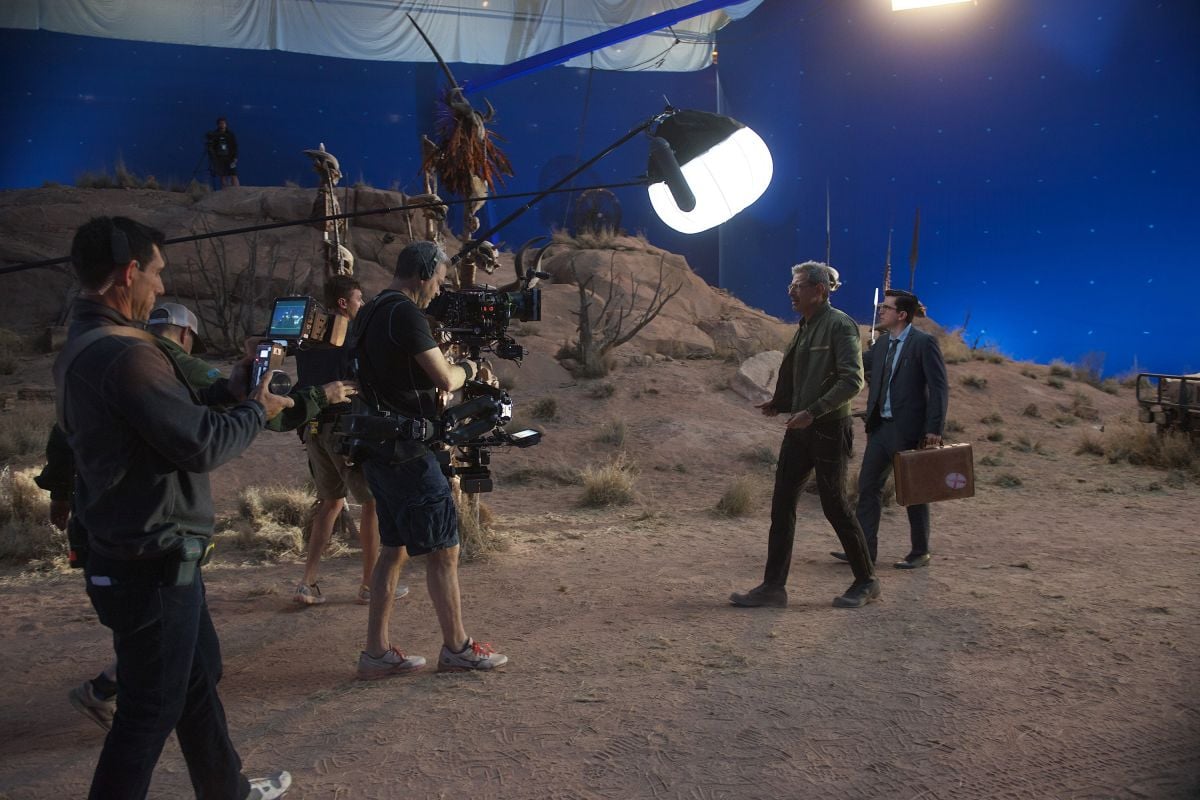
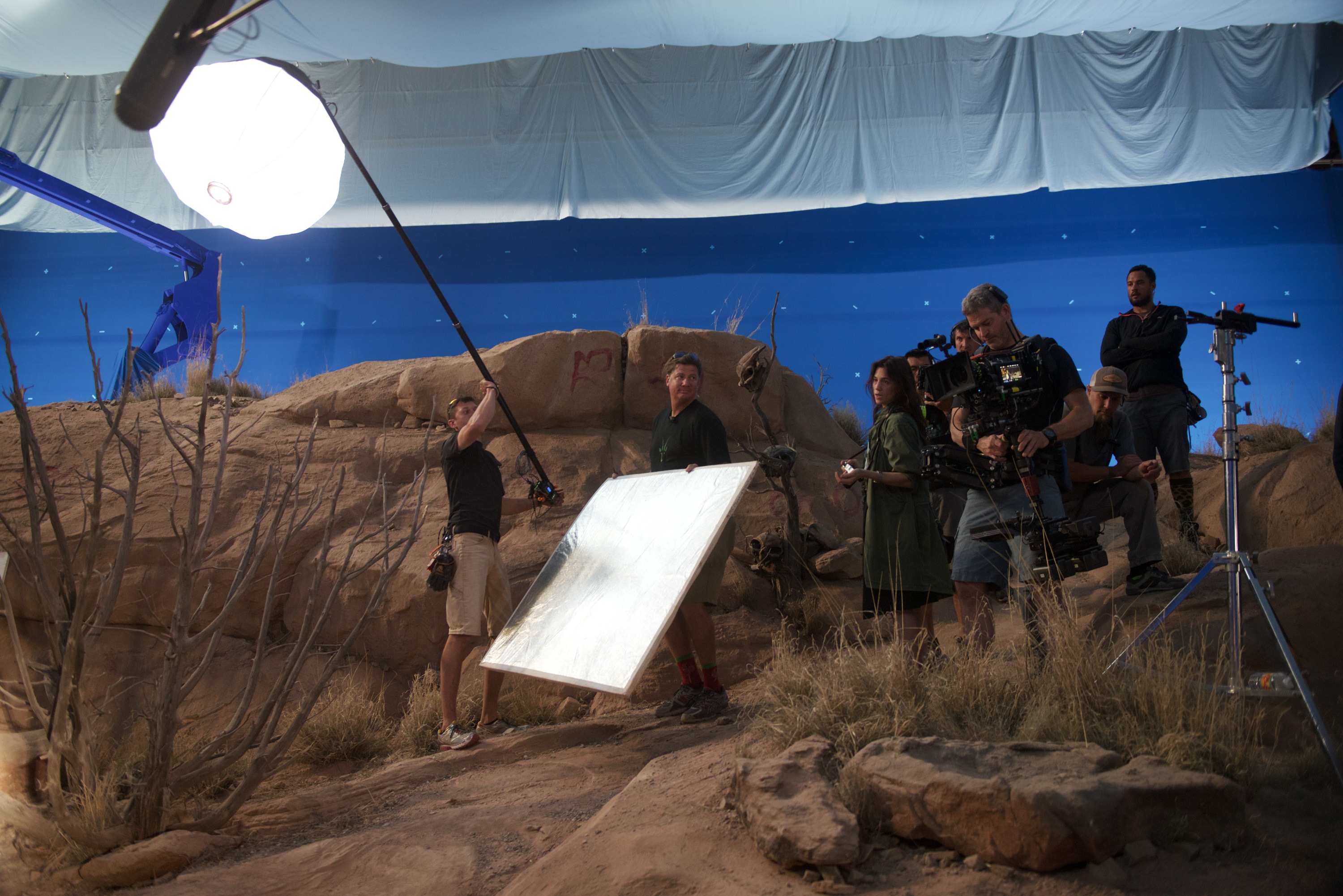
The LUT that was ultimately used was based on Kodak film-print emulation and also incorporated aspects similar to what happens in the toe of Fujifilm negative, while taking advantage of Red’s own color matrices as well. “With the film-print emulation, you get a really nice roll-off on the highlights, but we were still incorporating the native color space of the Red to get the detail in the shadow areas that film would compress,” Förderer details. “Some Fuji-like characteristics came in the shadow range to put just a little green shift into the low end. We loaded the LUT right into the Weapon camera, whereas the Dragons were connected to a Fujifilm IS-Mini LUT box for monitoring on set.
“This way, everyone was looking at the image the way we wanted, and this LUT was baked into the dailies so that Roland, the editors and our visual-effects artists were working with it from day one,” the cinematographer notes. “That makes a huge difference, because if you don’t have look management from set to post, and then you get into the color suite and set the original intention, everyone is thrown for a loop from the sudden change. I prefer to make sure that the intention follows through the entire process.”
The final grade was performed at FotoKem in Burbank. Förderer worked with Martin as well as colorist Walter Volpatto; the DI employed a 2K and 4K workflow, grading EXR files in Blackmagic Design’s DaVinci Resolve. “I worked with [Martin] to set the look for the 2D master and continued polishing with Walter Volpatto,” Förderer says. “We then did the 3D version and Dolby Vision HDR.
“I like working with just one LUT,” Förderer adds. “It’s like shooting the entire movie on one film stock. I don’t want to mess with 10 different looks for day and night, interior and exterior. Once I had the LUT, I knew I was lighting for that specific look and everything we were doing was going to work with that LUT, because I was seeing the results immediately. Other than that, we didn’t do any grading on set or for dailies.” Jeroen Hendriks served as on-set digital-imaging technician throughout the shoot.

Even on a tentpole production the size of Independence Day: Resurgence, speed and efficiency were paramount, as the feature — generally a two-camera show — was shot almost entirely onstage in Albuquerque, N.M., over the course of a scant 78 days. It thus took a bit of convincing for Emmerich to consider anamorphic lenses, according to Förderer, who ultimately decided upon Vantage Film 2x anamorphics — Hawk V-Plus zooms and Hawk V-Lite primes. “Roland used to be a big spherical guy, and he really likes to use zooms to be fast,” the cinematographer says. “He saw me work with the Hawk Front Anamorphic zooms on Stonewall, and saw how fast I could be with them and still get an interesting look, and that helped convince him. He loves the look of anamorphic lenses and how they render skin. I’ve worked with the Hawks several times, and I think they have the right balance of being a newer lens but with a really nice organic look. The Hawks have all the things we love about anamorphics — the all-important oval bokeh and the wonderful characteristics of light distortion and subtle flare.” The production made frequent use of the V-Plus Front Anamorphic 45-90mm and 80-180mm zooms (both T2.8). The Arri/Fujinon Alura 15.5-45mm (T2.8) zoom was also employed on the production, as well as Zeiss Compact zooms — the latter mainly for visual-effects plates.
“I like to use digital cameras to our advantage,” Förderer emphasizes. As an example, he offers, “Sometimes you just want to be a little tighter on a shot, and changing a lens or moving the camera can take too long in the middle of an intense scene, even with an amazing crew. In those situations I just crop in on the sensor, changing down to 4K instead of 6K, and that lets me get a little tighter. You can click a button and get a different field of view. In a wide shot you want as much detail as you can get, but in a tighter shot you’ll never see the difference, and you still have plenty of resolution to work with. It’s a wonderful tool that allows you to move really fast.”
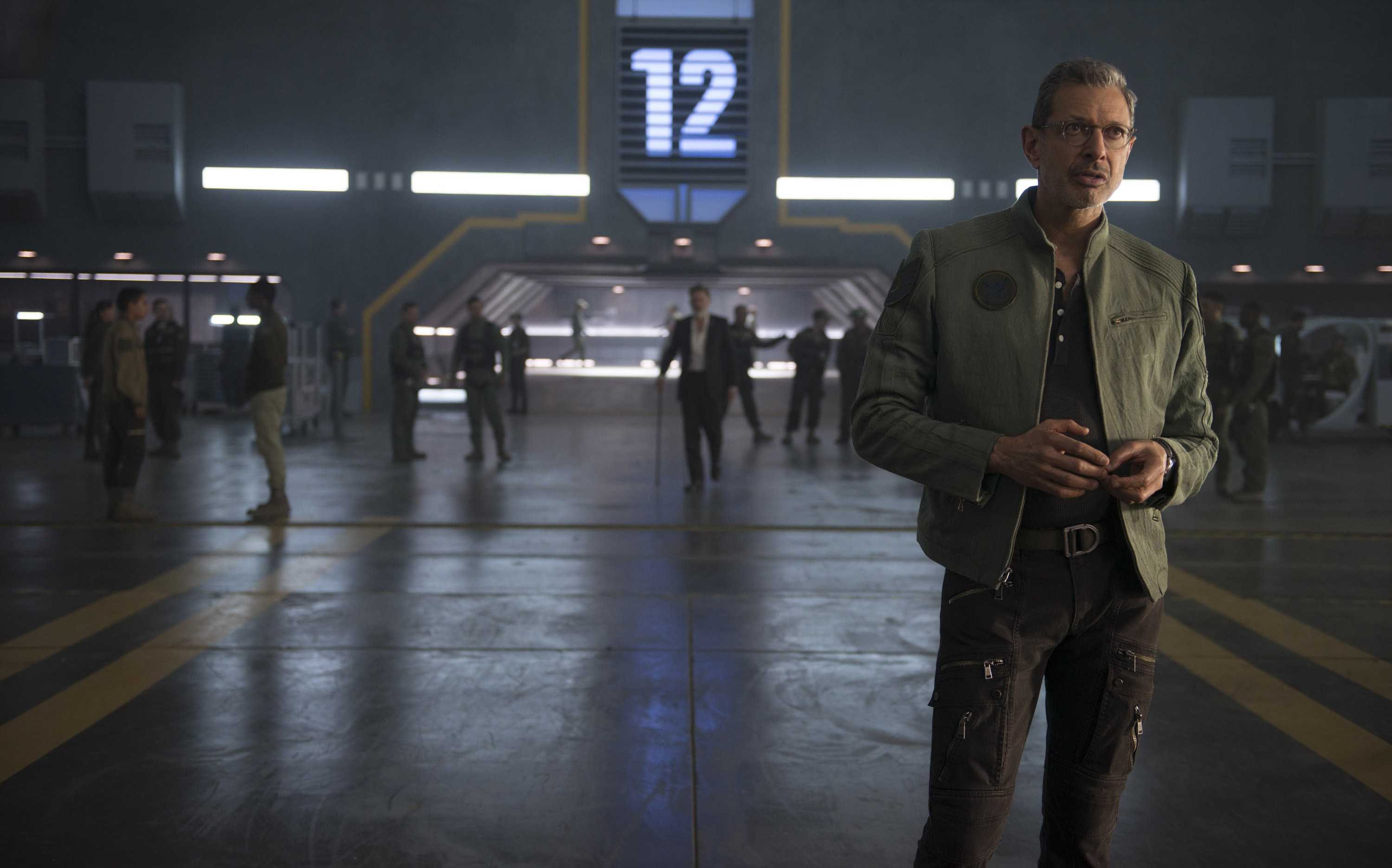
Generally desiring full control of the environment, Emmerich prefers to shoot nearly everything on stage. “Roland loves magic hour — that ‘last kiss of sunlight’ is his favorite,” Förderer says with a laugh. “We’ve got, like, 10 different variations of it. Obviously, you have to do that on stage or you’d only have 20 minutes, tops, to shoot every scene, and then the light would be gone.”
In order to achieve even greater control, the cinematographer made the unorthodox decision to forgo traditional lighting sources and light the feature nearly entirely with LED units. “With only a few minor exceptions, we lit the entire movie with RGBW LED fixtures,” he explains. “Working with RGBW LEDs is basically like grading on set, except you’re adjusting color timing with the lighting instead of manipulating a video file. We had everything hooked up to a dimmer board, and we could change the color of any fixture at any time. Our dimmer-board operator, Kevin Hogan, had an iPad to do simple corrections of brightness and color, [though] complex effect sequences timed to certain cues would only be possible from the big dimmer board.”
In prep, Förderer set several base looks for the mix of RGBW colors, which he would call “tungsten” and “daylight,” along with several other preset looks. “The out-of-the-box presets for daylight and tungsten didn’t really hit what I wanted, especially with the combination of our show LUT,” he explains. “We created a few presets for each light so we could have a place to start, and then say, ‘Dial in 10 percent more red,’ ‘5 percent less blue,’ ‘Make this one a little cooler, that one a little warmer, and pull some green out of that one.’ There were no gels at all; color was created in the fixtures themselves. It became like printer lights, and after a while it was just intuitive. Roland is so ambitious and there was so much coverage, there’s simply no downtime — you have to be efficient, and this system allowed us to move incredibly fast.”
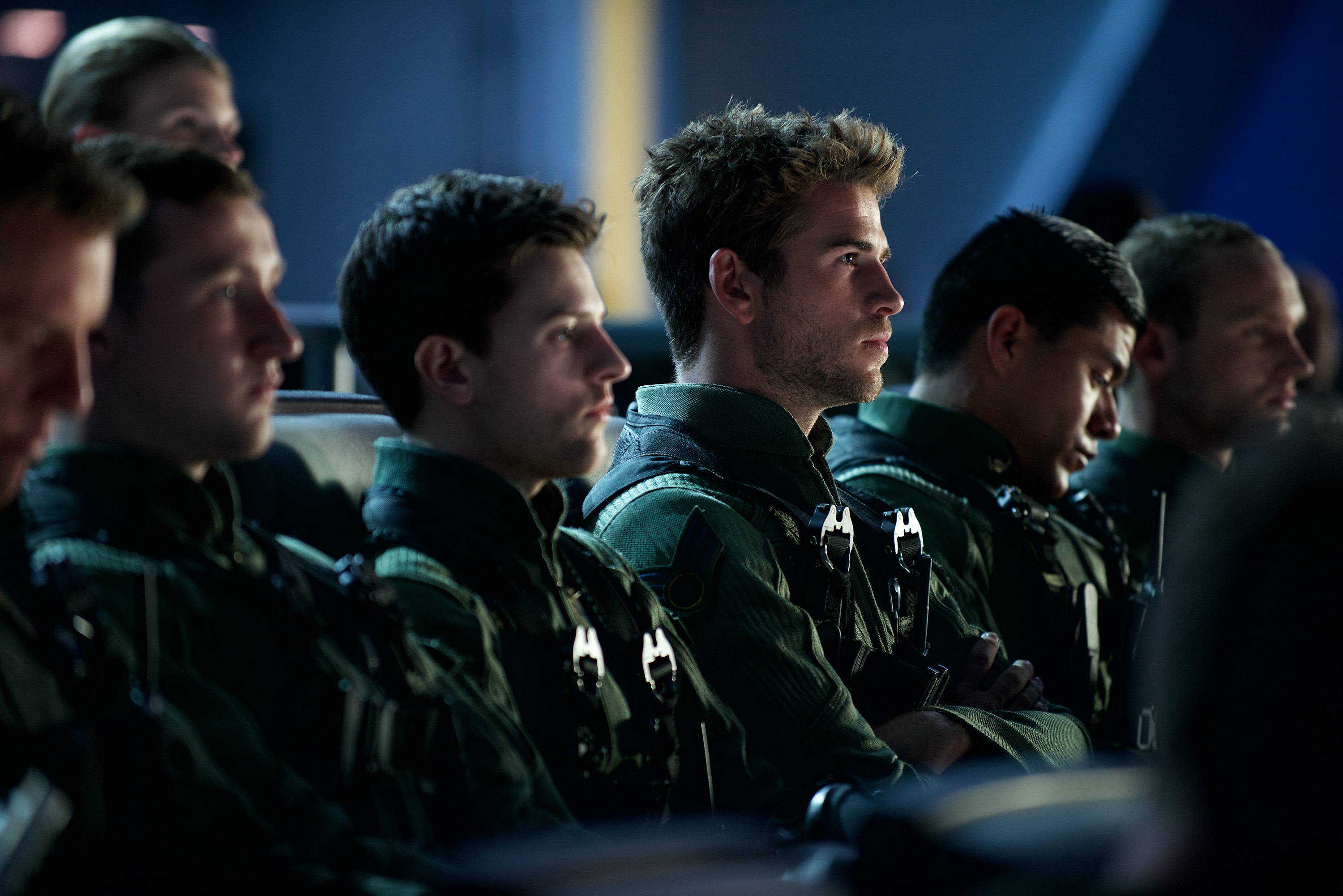
To maintain color consistency, Förderer primarily limited his choices of LED fixtures to two brands: LiteGear LiteRibbon LED strips and Digital Sputnik DS 6 LED fixtures. “One of the problems with LED technology is that the color and spectrum of the lights vary so much from manufacturer to manufacturer,” he notes. “Mixing and matching can be a nightmare, so I stuck with limited choices. Sometimes even various batches of LEDs from the same manufacturer can have a different spectrum, so we had to be careful.”
Also during prep, gaffer Jay Kemp collaborated with LiteRibbon to create custom 4'x4' and 6'x6' soft sources that were lined with RGBW LEDs. “These fixtures were basically a self-lit diffusion frame,” Förderer explains. “I essentially used them for every setup. I don’t like stands; I believe filmmaking and stands are enemies. Wherever you put a stand, you can’t point a camera. With traditional soft lights you have a stand for the light and a stand for the diffusion and stands for the flags — it gets crazy. With these fixtures there was only one stand, and it was all self-contained.” To control the soft light, the cinematographer employed custom 30- and 40-degree DOPChoice Snapgrids — soft egg-crate accessories that attach quickly to fixture frames — which eliminated the need for flags.
LiteRibbon LED strips were also integrated into the production design. Practical fixtures were fitted with LED clusters instead of traditional tungsten bulbs, thus allowing the cinema-tographer to easily dial-in intensity and color on a shot-by-shot basis. A wide shot might have had a practical at 30-percent intensity, for example, but when the camera moved in for a close-up, the cinematographer would increase the intensity to accentuate the modeling on the actors without introducing new fixtures into the setup.
“We built the LiteRibbon into the set wherever it made sense,” the cinematographer explains. “When I needed something harder [and] punchier, I went with the Digital Sputnik fixtures, which are very powerful LED lights with narrow beams. You can group them in clusters, and they work as a great hard light.”
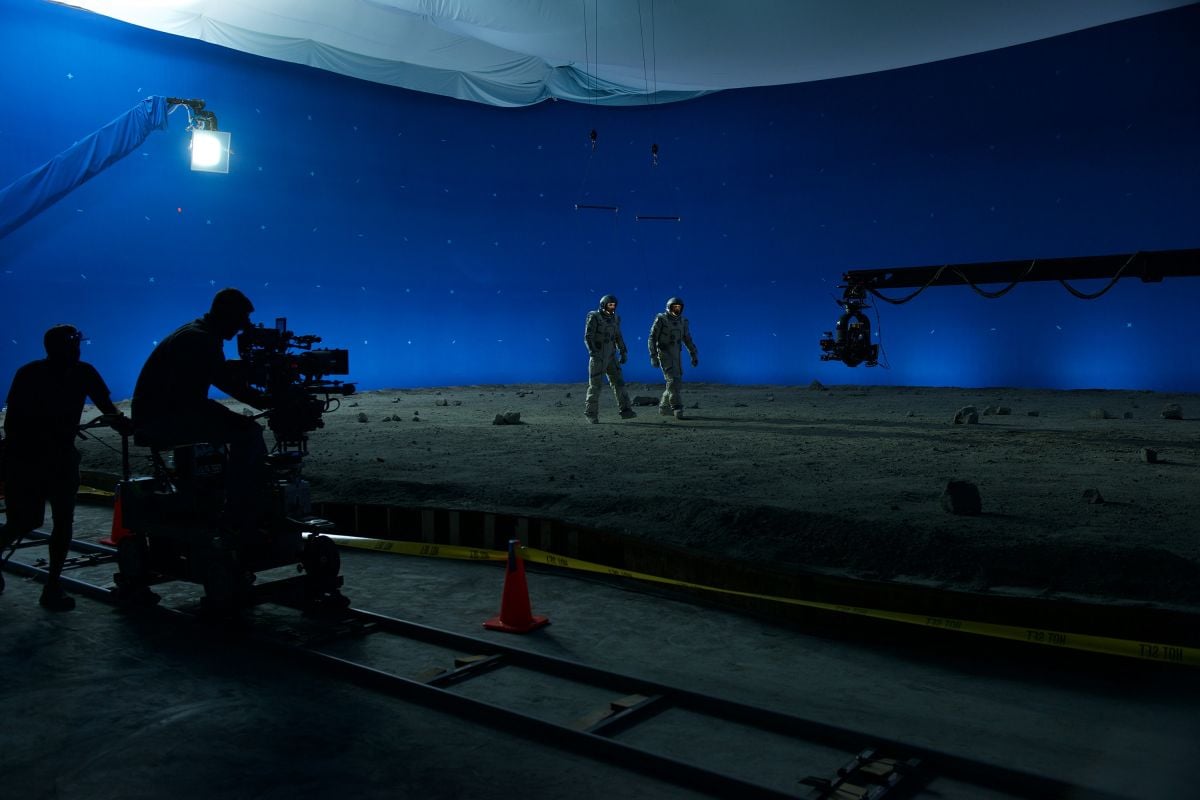
The cinematographer also takes an unorthodox approach to his lighting of bluescreen, which surrounded many of the project’s soundstages. Instead of reaching for the traditional Kino Flo or cyc lights — or even space lights — Förderer elected to line the entire ceiling of the stages with day-blue colored muslin. He would then bounce light into the muslin, to both serve as toplight and to gently light the bluescreen with soft fill from above. When he needed some “punch” on the bluescreen, he placed a BBS Lighting Area 48 remote-phosphor LED fixture on the floor — literally, with no stands or base — and pointed it as necessary. “We had 20 of those Area 48 fixtures to fill in holes where needed,” the cinematographer says. “They fit in tight spaces behind cars, rocks or even people.”
To light the muslin-bounce setup, Förderer employed combinations of Digital Sputnik LED fixtures, 4K and 9K HMI Pars, and Area 48 units. “We had seven stages, including a huge ice-hockey stadium, in Albuquerque that were all lined with 360-degree bluescreen,” the cinematographer recalls. “I didn’t rig any lights on the ceiling. It would have been so expensive to have all these stages pre-rigged with lights that just sat there as we moved from one stage to another. Muslin is lightweight and easy to hang, and then you only have a couple units on the ground to bounce into it. It’s much better than a perm lined with space lights, and much more efficient and less ‘source-y.’ I think it’s a common mistake when shooting on stage — it doesn’t represent natural daylight realistically. The sky is a large, soft [source], and that’s what I try to replicate with a perm full of fabric.” He adds that the muslin bounce “reflects a much cooler color onto skin.”
The muslin also served the production well in terms of Emmerich’s preference for using practical cars on stage. “With cars there are glass and reflections,” Förderer says. “I really prefer to use the muslin ceilings in these situations, as it provides a much more realistic reflection in the glass.” Taking this concern further, Förderer experimented with gobo projections of clouds on the overhead muslin to provide some texture in the reflections. “It wasn’t exactly perfect,” he says, “but I think it helped to add a little extra element to make it more realistic.”

The production additionally employed Outsight’s Creamsource Sky full-spectrum LED soft source “for interactive lighting effects,” Förderer notes. “Due to [its] high output and wide spread, we could program it to switch between explosion light and green alien laser-fire effects.”
From his time working with Emmerich, Förderer reports that he’s learned important lessons in “visual sleight of hand.” He explains, “It’s understanding the psychology of the eye, and misdirection from where the trick is happening. The eye is [attracted] first to the brightest portion of the frame, and then to the movement in the frame, and then it looks for eyes.”
Applying this to bluescreen work, the filmmakers opted to place their main actors in front of real objects — “a plane, a wall, a rock,” Förderer suggests — such that matte lines would appear around those objects rather than around the actors themselves. Thus the break between in-camera and visual-effects imagery appears where it won’t be “as scrutinized or important,” the cinematographer explains. “This makes the shot not only cheaper but that much more effective. Roland is a master at this. He has an ‘eagle eye’ for making sure that the principal elements of a shot have clean silhouettes that [don’t overlap] the effects. In a movie like Independence Day, when you’re cutting to a new shot every few seconds, you only have to deflect [the viewers’] attention for a short period of time.
“So many cinematographers and gaffers obsess about the perfect blue- and greenscreen,” Förderer continues. “They spend hours carefully making sure it’s all evenly lit and always at a consistent stop. The truth is, as long as you have an evenly lit area around your main subject and enough contrast to separate the subject from the background, the rest of it doesn’t matter. The effects artists will matte it out, anyway.”
One sequence shot on stage in New Mexico employed photographic backings. While in the first Independence Day an iconic scene featured Will Smith’s character dragging an alien across the barren Bonneville Salt Flats in northwestern Utah, this time around the flats are the setting where a school bus full of children race for their lives. Concerned about the cost and practicality of sending the production to the salt flats, the producers asked Förderer whether there might be another solution. After scouting the flats, the cinematographer determined in this specific case that there was no benefit to shooting on location.
“We went to look at the salt flats, and there’s no depth out there at all,” he says. “It’s infinite white space, almost like snow, and mountains so far away that there’s no parallax. You have no sense of distance whatsoever. I said, ‘There’s no point going there to shoot. We can easily do this on stage.’ I shot plates with a Red Dragon, shooting at a very tight shutter angle and slowly panning 360 degrees. We then extracted stills from this footage and I sent them to Rosco, and they created one huge photographic backing for us.”
The production opted for Rosco’s SoftDrop backings, which are made from a woven, wrinkle-resistant, all-natural cotton fabric. The SoftDrop falls easily with minimal creases, can be backlit and has essentially no sheen. “One of the things to keep in mind with a backdrop like this is to let it blow out a little,” Förderer notes. “Let it lose a little detail, which will make it feel real. People make that mistake a lot and they expose ‘properly,’ and then it looks fake — it’s too controlled.”

Independence Day: Resurgence had one principal unit, with no second unit. “On these big films, no one questions having a second unit,” Förderer attests. “But they’re not always as efficient as you want them to be. To give the director options, they’ll generally shoot way more than the first unit would shoot, and if you don’t like it you end up throwing it out and reshooting it anyway. We budgeted it in from the beginning that we would be shooting all our own inserts and cutaways, and figured an extra two to three hours each day to get that stuff — but it makes sense. You’re already lit for it and you know exactly what you want and need. Sure, it means the actors might have to stand around a little bit while you shoot a piece of paper on a desk, but in the end it’s a lot more efficient and cost effective.” Förderer reports that the production employed approximately two days of separate stunt inserts.
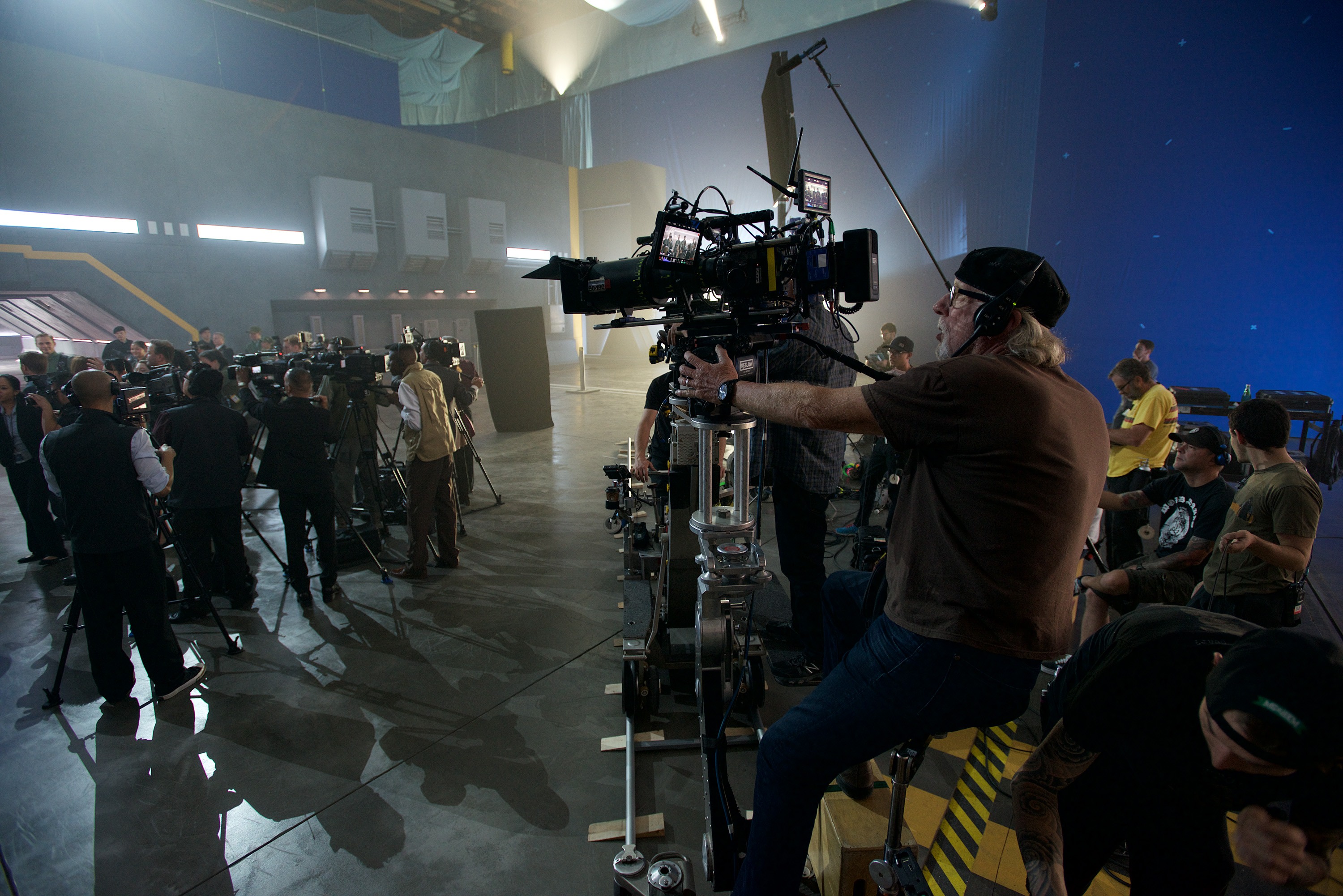
The filmmakers capture an onscreen media event in an ESD base.As is the director’s preference, Emmerich’s master shots were most often captured with a moving camera. Noting that “camera movement is designed to not attract any attention,” Förderer expresses the importance of being “very smooth, always in the right place and always moving. There’s a lot of Technocrane and Steadicam [on this project] to keep the image alive at all times. We also knew this was going to be a 3D movie [following a stereoscopic conversion in postproduction handled by Stereo D], and movement is very important in 3D for depth perception. There was no set rulebook for how and when we moved — it was mostly motivated by characters and story.” The production also made use of dollies, tracks and handheld. François Daignault served as A-camera, Steadicam and Technocrane operator.
To ensure smooth cuts with the master shot, Emmerich’s coverage tended to be moving, as well. “You end up with this master shot and all of these people choreographed and moving through the frame with incredible precision,” Förderer says. “Then we go into coverage and every shot covers the full action, even if you’re moving on a 135mm lens for a close-up! Sometimes it’s impossible to keep focus on those shots, but you know you have other moments to [cut away to], since every shot covers all the action.
“Roland organizes and orchestrates all the actors and background,” Förderer relates. “We talk [briefly] about where to place cameras, we do one rehearsal, and he sees what will potentially be a problem in close-up five or 10 setups later, and we change it for the master to avoid the problem later. It’s a big puzzle, and it’s a challenge to light this way because we’re basically always lighting for 360 degrees. We might bring in a diffusion frame from time to time if we’re shooting a special close-up, but otherwise our master look is what we run with for the coverage. This is where LED really helps; it’s quick and easy to dial in a little more backlight or fade up or down an area as we pass by it. It’s amazing how fast it can go.”
In commending the crew of Independence Day: Resurgence, Förderer acknowledges “key grip Kurt Kornemann and his team, who were phenomenal and always open to new ideas, and gaffer Jay Kemp, who jumped deep into using brand-new LED technology like the Digital Sputniks.”
The cinematographer, who is still in his early 30s, admits, “I get flack sometimes for being so young. Roland told the studio that I was his guy and they didn’t question it, but then they met me and they were like, ‘Oh, my God! You’re a baby! Is this legal?’” Förderer says with a laugh — and adds in conclusion, “People ask me, ‘You’re so young, how can you handle this big show?’ The truth is that it’s no different from any other show. You have a schedule, you have shots and coverage, you have lighting and lenses and camera, and you deal with it all one shot at a time. Big budget, small budget — it’s all about being prepared and creating the best image you can, and that’s how I approached this film.”
The cinematographer was invited to become a member of the ASC in 2019.






